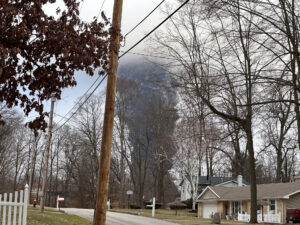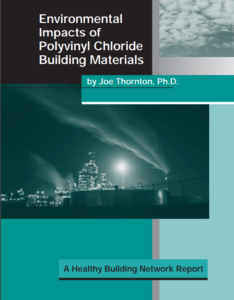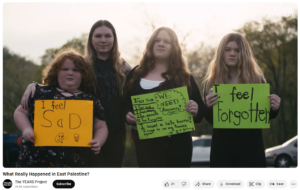Vinyl Chloride Haunts East Palestine
Health risks raise questions about safety of plastic production

One year after a train derailment contaminated the town of East Palestine, Ohio, with over a million pounds of toxic vinyl chloride, consequences of the disaster continue to impact the community of over 4,500 residents. Widely used in polyvinyl chloride (PVC) plastics, vinyl chloride can trigger both acute and chronic health issues including damage to the central nervous system; increased risk of liver, brain, and lung cancer; and irritation of eye, nose, throat, and lung tissues.
Disaster responses were botched by both industry representatives and government officials, exposing residents to health risks. Insufficient testing led to premature lifting of evacuation orders for example. Speaking with a reporter for the Allegheny Front, Andrew Whelton, a professor of civil, environmental, and ecological engineering at Purdue University said “Residents and business owners were encouraged to go back into their contaminated buildings. They should have tested correctly and applied the precautionary principle.”
 These and other failures left many residents feeling their health was less important than the political and financial concerns of corporations. “Our kids are poisoned,” said resident and community activist Jami Wallace, “and no one will help us.”
These and other failures left many residents feeling their health was less important than the political and financial concerns of corporations. “Our kids are poisoned,” said resident and community activist Jami Wallace, “and no one will help us.”
The continuing problems highlight hidden costs associated with production of PVC plastics. The Healthy Building Network (HBN) calls PVC “the antithesis of a green building material.” They further have found that ”the hazards posed by dioxins, phthalates, metals, vinyl chloride, and ethylene dichloride are largely unique to PVC… the only major building material and the only major plastic that contains chlorine or requires plasticizers or stabilizers.”
Despite PVC’s poor health and environmental rating, however, the construction industry continues to use it widely for plumbing systems and other building elements. A separate HBN report – Environmental Impacts of Polyvinyl Chloride Building Materials – found that building and construction applications account for an estimated 75 percent of all vinyl consumption.
Based on the health and safety risks, many regional and national groups have called for greater oversight of vinyl chloride and other hazardous chemicals used in plastics production. Heather McTeer Toney, a former EPA administrator, told the Associated Press that the release of toxic chemicals represents “a chilling warning that we must act now to ban petrochemicals like vinyl chloride.”
Unsurprisingly, some in the plastics industry dispute the risks associated with vinyl chloride and PVC. In a statement, Ned Monroe of the Vinyl Institute criticized calls to increase regulation as a “publicity stunt that irresponsibly ignores decades of credible science… to advance deceptive and disproven claims.”
 The residents of East Palestine might not agree. A recent documentary on East Palestine produced by the YEARS Project bluntly describes the reason that residents continue to suffer physical and psychological damage: “This wasn’t about the safety of the people, it was about the finances of a multi-billion-dollar company,” they said.
The residents of East Palestine might not agree. A recent documentary on East Palestine produced by the YEARS Project bluntly describes the reason that residents continue to suffer physical and psychological damage: “This wasn’t about the safety of the people, it was about the finances of a multi-billion-dollar company,” they said.
Says Judith Enck, a former EPA administrator and current director of the nonprofit Beyond Plastics, “This is not rocket science. It is political science. This is standing up to special interests…people deserve so much more than they’re getting right now.”
